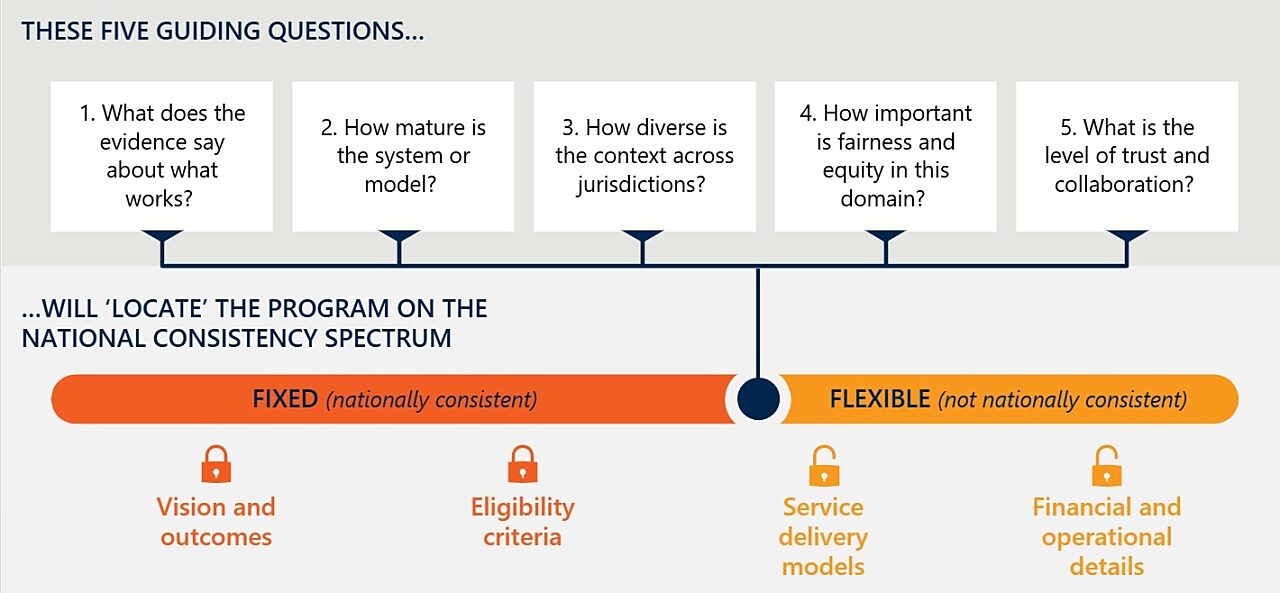Idea In Brief
National consistency and local flexibility are often in tension
This dynamic is particularly challenging in systems that span Commonwealth and state/territory boundaries, where unified approaches clash with unique local contexts.
Consistency enables equity, but local adaptation is a must
The challenge lies in determining what needs to be consistent and what can be adapted to local needs.
National consistency exists on a spectrum, not as a binary concept
The article presents a framework with guiding questions to help policymakers decide which elements should be fixed and which should remain flexible.
When it comes to designing and implementing national initiatives, services and programs in a federated system like Australia’s, the tension between national consistency and local flexibility is a recurring challenge. This tension is particularly pronounced in systems and services that work across commonwealth and state/territory boundaries, where the need for a unified approach often clashes with the unique contexts and priorities of jurisdictions. Every jurisdiction has different characteristics, demographics, operating contexts and histories, and this dynamic can create an impasse, where progress stalls because stakeholders are often talking past each other, holding different interpretations of what “national consistency” actually means and when it's needed.
We all agree that consistency matters for fairness: everyone should have access to quality, evidence-based services. But the reality is that what works in one place often won't work everywhere else. Different regions have different demographics, existing services, funding arrangements, and community needs. The challenge isn't choosing between consistency or flexibility. It's figuring out what specifically needs to be consistent, and what should be adapted locally.
But the truth is that the concept of national consistency is not, or need not be, monolithic. Think of it as a spectrum, from broad shared goals at one end to specific detailed operational requirements at the other. The challenge is determining what does need to be consistent when designing and implementing a new model or initiative and what should be changed to respond to the local context. This article presents a simple framework to help policymakers navigate this spectrum and have more productive conversations about what should be fixed and what should be flexible.
The spectrum of national consistency: What are we really talking about?
National consistency isn’t binary. It’s a spectrum. Our framework outlines four levels of possible consistency and flexibility:
Vision and outcomes. At the most flexible end, national consistency simply means agreeing on what you're trying to achieve. A national housing initiative might define broad outcomes like “reducing homelessness by 25 per cent” while leaving jurisdictions completely free to determine their own strategies. This preserves maximum local flexibility while ensuring everyone works toward the same national goals.
Eligibility criteria. Moving further along the spectrum, you might standardise who gets help. This could mean setting uniform eligibility criteria, such as “anyone earning under $40,000 qualifies” or “all children and young people with a developmental concern,” while still allowing states to use their own assessment systems. You're fixing the who but keeping flexibility in the how.
Service delivery models. Further right, consistency begins to shape what the model of support looks like. You might require that 60 per cent of funding goes to emergency housing and 40 per cent to prevention programs, or mandate that all programs include certain “core components” like case management. You're now fixing both the who and much of the what.
Financial and operational details. At the most prescriptive end of the spectrum, you're standardising the nuts and bolts: identical funding models, data systems, and reporting requirements. But here's the catch. The further down you go, the less meaningful consistency becomes and the more you risk creating bureaucratic burden and prescription without real benefit.
The key insight: You don’t need to make everything nationally consistent. Most successful programs choose their level on the spectrum deliberately, fixing only what’s necessary and leaving the rest flexible to reflect local realities.
Determining fixedness: Five questions to guide design decisions
Once you've understood the spectrum, the next step is deciding the degree of flexibility for your program or initiative. Determining the right level of consistency is rarely straightforward. These five questions help assess which elements should be fixed nationally, and which should remain flexible to reflect local contexts, but judgement and context still matter.
What does the evidence say about what works? Where strong evidence supports specific approaches, those elements can be fixed with confidence. Where the evidence is still emerging or of there are gaps for some population groups or contexts, flexibility allows for experimentation and learning.
How mature is the system or model? If the system or model is well-established with a strong evidence base it may support more fixed elements. In contrast, emerging models benefit from flexibility to foster innovation and learning.
How diverse is the context across jurisdictions? Significant differences in local policy, legislation, funding, service ecosystems, or community needs calls for flexibility which ensures the model remains relevant and effective across varied settings.
How important is fairness and equity in this domain? If equal access or outcomes are a priority, some elements – like eligibility criteria – may need to be fixed. But service delivery methods can remain flexible to suit local needs.
What is the level of trust and collaboration? High trust and a shared commitment between the Commonwealth and jurisdictions to co-design and joint problem-solving enables more flexible arrangements with shared accountability and towards shared goals.


Fix or flex: Applying the spectrum in practice
The strength of this framework lies in its adaptability. Not all programs require the same level of national consistency. Context matters.
In some cases, it makes sense to move further along the spectrum, fixing multiple elements. This is typically appropriate when best practice is well-established, the target population is clearly defined, and contexts are consistent across jurisdictions.
Take the National Immunisation Program. It makes sense to fix the vision (prevent disease outbreaks), the eligibility (which vaccines for which age groups), the service model (standardised vaccines and schedules), and even operational details (adverse event reporting). This works because the science is clear, the target population is universal, and vaccines function the same way whether you're in Perth or Cairns. Work Health and Safety laws follow a similar pattern: evidence is strong, and the risks are consistent, so prescriptive design makes sense.
In other cases, it’s wiser to stay toward the flexible end of the spectrum. This is especially true where local contexts vary significantly, community needs are diverse, or best practices are still evolving.
Consider supported accommodation for people with mental health needs. Here, you might fix only the vision and outcomes – such as “ensure people have stable housing that supports their recovery” – and leave the rest flexible. What works in remote First Nations communities may differ dramatically from mainstream or only metro approaches, and we’re still learning what models are most effective. The same applies to early childhood and domestic violence services, where local needs, resources, and workforces vary widely. Fix the outcomes but let communities and jurisdictions shape the delivery to suit their context.
It is also worth noting that the position on the spectrum isn’t static. It can shift as programs mature and new insights emerge. Evaluations play a key role in this by helping identify what works, for whom, and under what conditions, which may justify adjusting the level of consistency over time.
A practical tool for collaboration
Beyond clarifying what national consistency actually means, this framework serves as a practical tool for better collaboration. Instead of arguing past each other about "consistency," stakeholders can now point to specific elements and say "we need to fix this, but keep that level flexible." This shared language is particularly valuable in Commonwealth-state negotiations, where vague assumptions about roles and responsibilities often create confusion and frustration.
The framework encourages stakeholders to ask three critical questions:
- How far along the spectrum should we go? Start with outcomes and only move to more detailed elements if there's clear evidence and consistent contexts. And trust and governance are important enablers for this to work well.
- What's the risk if we get this wrong? High-stakes areas with proven solutions (like immunisation) justify more consistency. Emerging areas with diverse needs (like mental health housing) call for more flexibility.
- Who's accountable for what? Be explicit about whether the Commonwealth is setting the destination, the route, or both.
By answering these questions, stakeholders can align their efforts and focus on what truly matters: delivering better outcomes for individuals and families and ensuring value for money for the community.
A path forward
The choice between national consistency and local flexibility isn't either/or. It's about considering the context and what is known already in place. This framework gives policymakers a simple tool: decide how far along the spectrum your program needs to go, then stop there and let local adaptation take over.
The payoff is programs that actually work. Instead of creating solutions that try to work everywhere but end up working nowhere, we can design initiatives that achieve national goals while respecting local realities. That's how we build a service delivery system that truly meets the needs of all Australians.
Get in touch to explore how we can support your policymaking efforts.
Connect with Monique Jackson, Claire McCullagh, and Michael Hood on LinkedIn.



